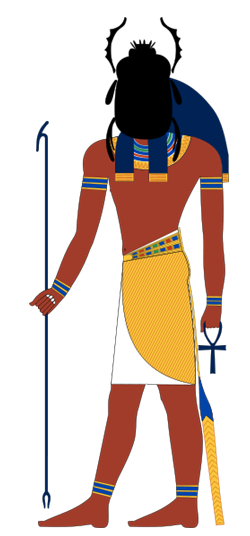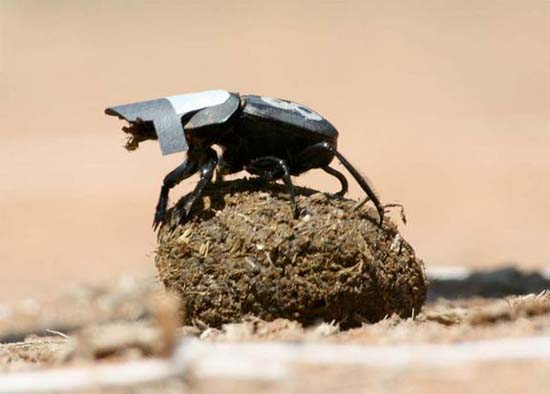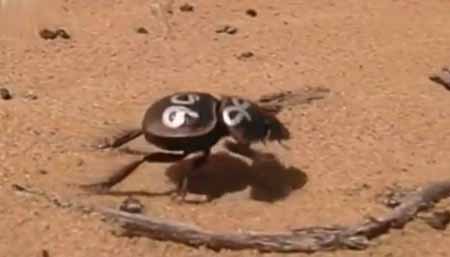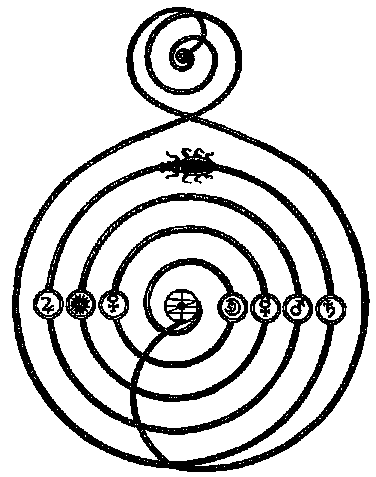

The dung beetle - winged scarab - enjoyed a sacred status among the ancient Egyptians. The image of the scarab, conveyed ideas of transformation, renewal, and resurrection, as is found in ancient Egyptian religious and funerary art. This potent symbolism appears in tomb paintings, manuscripts, hieroglyphic inscriptions on buildings and carvings. In addition to its use as an amulet for the living and the dead, scarabs adorned jewelry including necklaces, bracelets, wrist cuffs and wide decorative collars. A bracelet from the tomb of Tutankhamun featured a bright blue scarab holding a cartouche between its front legs. A cartouche is an oval frame that encloses a name. The ancient Egyptians sometimes painted or carved scarabs on a deceased person's sarcophagus, the human-shaped coffin that held the mummy. Scarabs often hold a sun disk over their heads.
The scarab was linked to the god Khepri the god of the rising sun. The ancients believed that the dung beetle was only male in gender, and reproduced by depositing semen into a dung ball. The supposed self-creation of the beetle resembles that of Khepri, who creates himself out of nothing. The dung ball rolled by a dung beetle resembles the sun.

Just as the belt stars of the constellation Orion are linked to ancient Egypt, so too is the center of the Milky Way Galaxy. In Egyptian mythology, the Milky Way was considered a pool of cow's milk. It was deified as fertility cow-goddess Hathor. The Milky Way was considered to be the Celestial Nile - the earthly Water of Life to the Ancient Egyptians. Without the Nile there would have been no great Ancient Egyptian civilization. The Milky Way represented the Waters of Life in which the Tree of Life had its roots.

Dung Beetles Navigate by the Stars Live Science - January 24, 2013
Despite having tiny brains, dung beetles are surprisingly decent navigators, able to follow straight paths as they roll poo balls they've collected away from a dung source. But it seems the insects' abilities are more remarkable than previously believed. Like ancient seafarers, dung beetles can navigate using the starry sky and the glow from the Milky Way, new research shows. This is the first time where we see animals using the Milky Way for orientation.
After locating a fresh pile of feces, dung beetles will often collect and roll away a large piece of spherical dung. The beetles climb on their dung balls and dance around in circles before taking off. This dance is not one of joy, however; the insects are checking out the sky to get their bearings.
The dorsal (upper) parts of the dung beetles' eyes are specialized to be able to analyze the direction of light polarization - the direction that light vibrates in. So when a beetle looks up, it's taking in the sun, the moon and the pattern of ambient polarized light. These celestial cues help the beetle avoid accidentally circling back to the poo pile, where other beetles may try to steal its food, Dacke said. In addition to these cues, Dacke and her team wondered if dung beetles can use stars for navigation, just as birds, seals and humans do. After all, they reasoned, dung beetles can somehow keep straight on clear, moonless nights.
To find out, the researchers timed how long dung beetles of the species Scarabaeus satyrus took to cross a circular arena with high walls blocking views of treetops and other landmarks. They tested the insects in South Africa under a moonlit sky, a moonless sky and an overcast sky. In some trials, the beetles were fitted with cardboard caps, which kept their eyes to the ground. Overall, the beetles had a difficult time traveling straight and took significantly longer to cross the arena if caps or clouds obstructed their view of the sky.

From the experiments, they thought that they could be using the stars for orientation, but dung beetles have such small eyes that they don't have the resolution, or sensitivity, to see individual stars. So the researchers moved their setup into a planetarium to tease out the information the beetles were extracting from the starry sky. They repeated the experiment under several different conditions, such as showing only the brightest stars, showing only the diffuse band of the Milky Way and showing the complete starry sky. The beetles took about the same amount of time to cross the arena when only the Milky Way was visible as when they could see a full star-filled sky. And they were slower to cross under all other conditions.
Previous experiments showed another dung beetle, S. zambesianus, is unable to roll along straight tracks on moonless nights when Earth's galaxy, the Milky Way, lies below the horizon, Dacke noted. Taken together, these results suggest dung beetles navigate using the gradient of light provided by the Milky Way. However, this technique would only work for beetles living in regions where the Milky Way is distinct. The researchers are now trying to determine the relative importance of the different sky cues dung beetles use.
When dung beetles dance, they photograph the firmament Science Daily - May 12, 2016
The discovery that dung beetles use the light of the Milky Way to navigate in the world has received much praise. Researchers have now taken a new step in understanding the existence of these unique beetles: when the beetles dance on top of a ball of dung, they simultaneously take a photograph -- a snapshot -- of how celestial bodies are positioned. They know where they are going and roll off with their ball of dung in a straight line across the savannah. Other animals and insects also use the position of celestial bodies to navigate, but the dung beetles are unique -- they are the only ones to take a snapshot where they gather information about how various celestial bodies, such as the sun, moon and stars, are positioned.
Fantastically Wrong: Why the Egyptians Worshiped Beetles That Eat Poop for a Living Wired - July 9, 2014
The dung beetle is incredible. Humans once revered it, from the ancient Egyptians to a 17th-century Jesuit who compared Christ to the bug. These folks got a whole lot wrong about the dung beetle and made some pretty fantastical assumptions, but it turns out that their reverence was totally justified. When the sun goes down, the dung beetles can use the moon to navigate. They use the Milky Way to orient themselves, the only known instance in the animal kingdom. The Greeks put it on a throne, claiming it was the king of the mythical pygmies - a race of tiny peoples at constant war with cranes (birds) - and went so far as to associate it with Zeus
 Dung beetle has galloping gait BBC - October 22, 2013
Dung beetle has galloping gait BBC - October 22, 2013
 Scientists have discovered that three species of dung beetle walk with a "galloping" gait not seen in any other insect. The vast majority of insect species walk with what is known as an alternating tripod gait - steadily moving forward three legs at a time. It is not clear why these flightless beetles have shifted so radically from the usual way of walking. The researchers wrote: "Like a bounding hare, the beetles propel their body forward by synchronously stepping with both middle legs and then both front legs." They beetles appeared simply to "drag" their back legs, they added.
Scientists have discovered that three species of dung beetle walk with a "galloping" gait not seen in any other insect. The vast majority of insect species walk with what is known as an alternating tripod gait - steadily moving forward three legs at a time. It is not clear why these flightless beetles have shifted so radically from the usual way of walking. The researchers wrote: "Like a bounding hare, the beetles propel their body forward by synchronously stepping with both middle legs and then both front legs." They beetles appeared simply to "drag" their back legs, they added.

Scarabs
Crystalinks
ANCIENT AND LOST CIVILIZATIONS